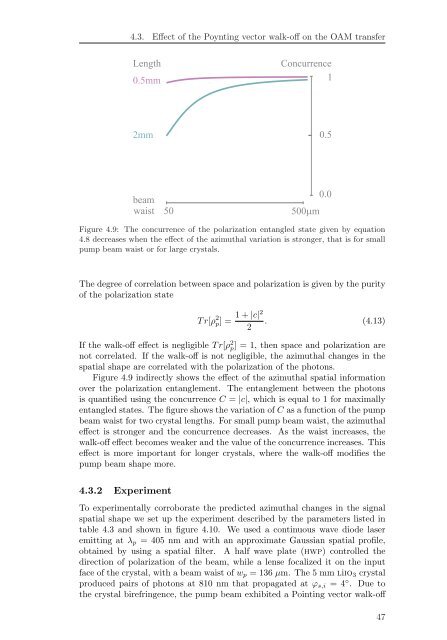Spatial Characterization Of Two-Photon States - GAP-Optique
Spatial Characterization Of Two-Photon States - GAP-Optique
Spatial Characterization Of Two-Photon States - GAP-Optique
Create successful ePaper yourself
Turn your PDF publications into a flip-book with our unique Google optimized e-Paper software.
4.3. Effect of the Poynting vector walk-off on the OAM transfer<br />
Length<br />
0.5mm<br />
2mm<br />
beam<br />
waist<br />
Concurrence<br />
1<br />
50 500m Figure 4.9: The concurrence of the polarization entangled state given by equation<br />
4.8 decreases when the effect of the azimuthal variation is stronger, that is for small<br />
pump beam waist or for large crystals.<br />
The degree of correlation between space and polarization is given by the purity<br />
of the polarization state<br />
T r[ρ 2 p] =<br />
0.5<br />
0.0<br />
1 + |c|2<br />
. (4.13)<br />
2<br />
If the walk-off effect is negligible T r[ρ 2 p] = 1, then space and polarization are<br />
not correlated. If the walk-off is not negligible, the azimuthal changes in the<br />
spatial shape are correlated with the polarization of the photons.<br />
Figure 4.9 indirectly shows the effect of the azimuthal spatial information<br />
over the polarization entanglement. The entanglement between the photons<br />
is quantified using the concurrence C = |c|, which is equal to 1 for maximally<br />
entangled states. The figure shows the variation of C as a function of the pump<br />
beam waist for two crystal lengths. For small pump beam waist, the azimuthal<br />
effect is stronger and the concurrence decreases. As the waist increases, the<br />
walk-off effect becomes weaker and the value of the concurrence increases. This<br />
effect is more important for longer crystals, where the walk-off modifies the<br />
pump beam shape more.<br />
4.3.2 Experiment<br />
To experimentally corroborate the predicted azimuthal changes in the signal<br />
spatial shape we set up the experiment described by the parameters listed in<br />
table 4.3 and shown in figure 4.10. We used a continuous wave diode laser<br />
emitting at λp = 405 nm and with an approximate Gaussian spatial profile,<br />
obtained by using a spatial filter. A half wave plate (hwp) controlled the<br />
direction of polarization of the beam, while a lense focalized it on the input<br />
face of the crystal, with a beam waist of wp = 136 µm. The 5 mm liio3 crystal<br />
produced pairs of photons at 810 nm that propagated at ϕs,i = 4 ◦ . Due to<br />
the crystal birefringence, the pump beam exhibited a Pointing vector walk-off<br />
47



